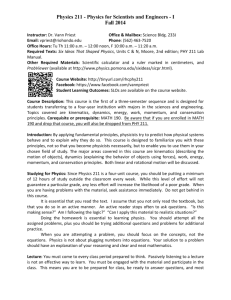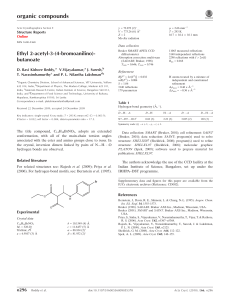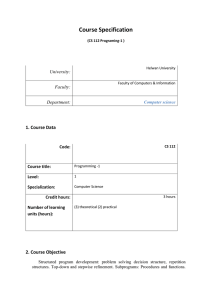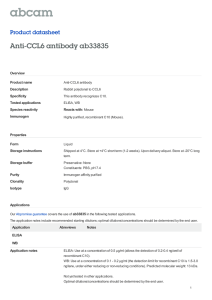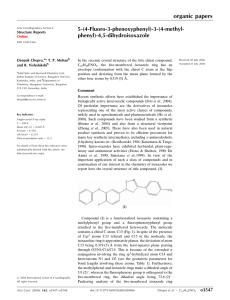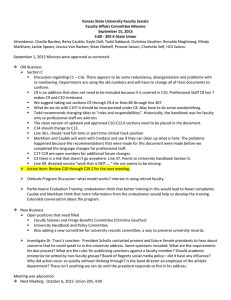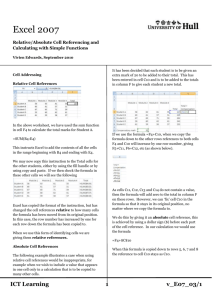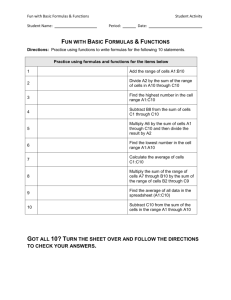Document 13581373
advertisement
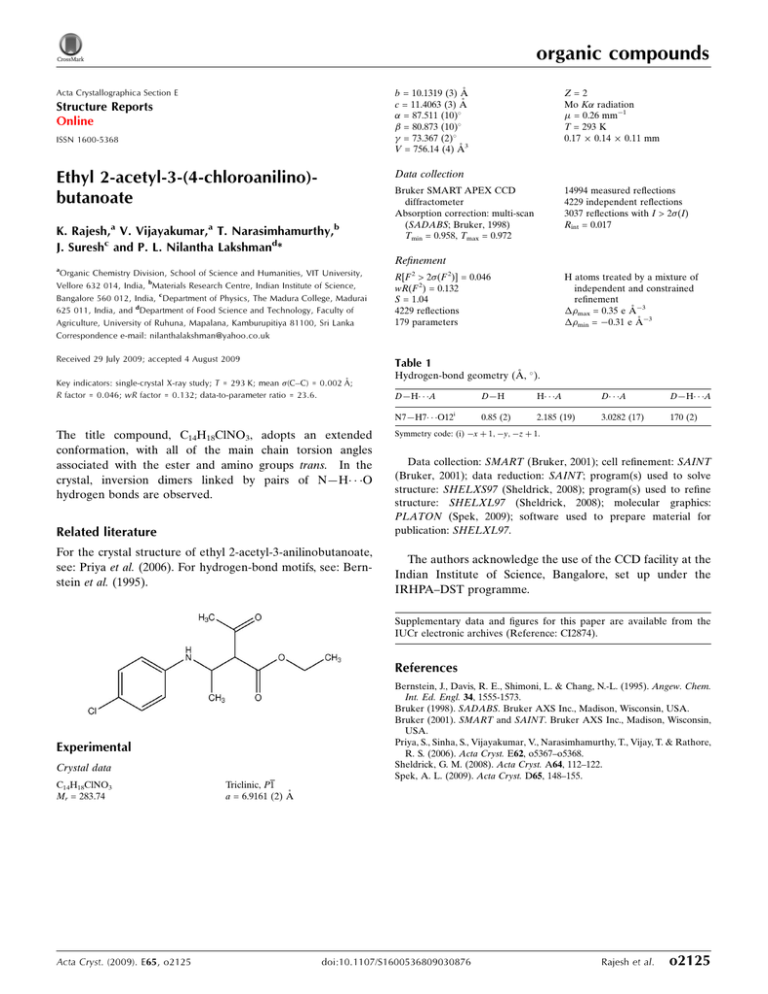
organic compounds Acta Crystallographica Section E b = 10.1319 (3) Å c = 11.4063 (3) Å = 87.511 (10) = 80.873 (10) = 73.367 (2) V = 756.14 (4) Å3 Structure Reports Online ISSN 1600-5368 Z=2 Mo K radiation = 0.26 mm1 T = 293 K 0.17 0.14 0.11 mm Data collection Ethyl 2-acetyl-3-(4-chloroanilino)butanoate K. Rajesh,a V. Vijayakumar,a T. Narasimhamurthy,b J. Sureshc and P. L. Nilantha Lakshmand* 14994 measured reflections 4229 independent reflections 3037 reflections with I > 2(I) Rint = 0.017 Bruker SMART APEX CCD diffractometer Absorption correction: multi-scan (SADABS; Bruker, 1998) Tmin = 0.958, Tmax = 0.972 Refinement a Organic Chemistry Division, School of Science and Humanities, VIT University, Vellore 632 014, India, bMaterials Research Centre, Indian Institute of Science, Bangalore 560 012, India, cDepartment of Physics, The Madura College, Madurai 625 011, India, and dDepartment of Food Science and Technology, Faculty of Agriculture, University of Ruhuna, Mapalana, Kamburupitiya 81100, Sri Lanka Correspondence e-mail: nilanthalakshman@yahoo.co.uk R[F 2 > 2(F 2)] = 0.046 wR(F 2) = 0.132 S = 1.04 4229 reflections 179 parameters Received 29 July 2009; accepted 4 August 2009 Table 1 Key indicators: single-crystal X-ray study; T = 293 K; mean (C–C) = 0.002 Å; R factor = 0.046; wR factor = 0.132; data-to-parameter ratio = 23.6. The title compound, C14H18ClNO3, conformation, with all of the main associated with the ester and amino crystal, inversion dimers linked by hydrogen bonds are observed. adopts an extended chain torsion angles groups trans. In the pairs of N—H O Related literature For the crystal structure of ethyl 2-acetyl-3-anilinobutanoate, see: Priya et al. (2006). For hydrogen-bond motifs, see: Bernstein et al. (1995). H atoms treated by a mixture of independent and constrained refinement max = 0.35 e Å3 min = 0.31 e Å3 Hydrogen-bond geometry (Å, ). D—H A D—H H A D A D—H A N7—H7 O12i 0.85 (2) 2.185 (19) 3.0282 (17) 170 (2) Symmetry code: (i) x þ 1; y; z þ 1. Data collection: SMART (Bruker, 2001); cell refinement: SAINT (Bruker, 2001); data reduction: SAINT; program(s) used to solve structure: SHELXS97 (Sheldrick, 2008); program(s) used to refine structure: SHELXL97 (Sheldrick, 2008); molecular graphics: PLATON (Spek, 2009); software used to prepare material for publication: SHELXL97. The authors acknowledge the use of the CCD facility at the Indian Institute of Science, Bangalore, set up under the IRHPA–DST programme. Supplementary data and figures for this paper are available from the IUCr electronic archives (Reference: CI2874). References Bernstein, J., Davis, R. E., Shimoni, L. & Chang, N.-L. (1995). Angew. Chem. Int. Ed. Engl. 34, 1555-1573. Bruker (1998). SADABS. Bruker AXS Inc., Madison, Wisconsin, USA. Bruker (2001). SMART and SAINT. Bruker AXS Inc., Madison, Wisconsin, USA. Priya, S., Sinha, S., Vijayakumar, V., Narasimhamurthy, T., Vijay, T. & Rathore, R. S. (2006). Acta Cryst. E62, o5367–o5368. Sheldrick, G. M. (2008). Acta Cryst. A64, 112–122. Spek, A. L. (2009). Acta Cryst. D65, 148–155. Experimental Crystal data C14H18ClNO3 Mr = 283.74 Acta Cryst. (2009). E65, o2125 Triclinic, P1 a = 6.9161 (2) Å doi:10.1107/S1600536809030876 Rajesh et al. o2125 supporting information supporting information Acta Cryst. (2009). E65, o2125 [doi:10.1107/S1600536809030876] Ethyl 2-acetyl-3-(4-chloroanilino)butanoate K. Rajesh, V. Vijayakumar, T. Narasimhamurthy, J. Suresh and P. L. Nilantha Lakshman S1. Comment Ethyl butanoate is commonly used as an artificial flavoring agent in alcoholic beverages, perfumery products and as a plasticizer for cellulose. The crystal structure of ethyl 2-acetyl-3-anilinobutanoate has been reported (Priya et al., 2006). In the title molecule (Fig. 1), there are three planar subunits viz. the chlorophenyl amine (C1-C6/N7/Cl1), acetyl (C10/C11/O12/C13) and ethyl acetate (C10/C14/O15/O16/C17/C18) groups. The chlorophenyl amino ring is inclined at angles of 76.28 (9) and 3.48 (7)° to the acetyl and ethyl acetate groups, respectively, with the acetyl group at an angle of 72.9 (1)° to the ethyl acetate group. The molecule adopts an extended conformation, with all of the main chain torsion angles associated with the ester and amino groups, i.e. from C18—C17—O16—C14 to C10—C8—N7—C1 lie in the range 157.20 (14)-178.59 (15)°. In the crystal structure, molecules associate into dimers through intermolecular N—H···O hydrogen bonds (Table 1). The hydrogen-bonded centrosymmetric dimers are characterized by an R22(12) ring motif (Fig. 2) (Bernstein et al., 1995). S2. Experimental A mixture of acetaldehyde (22.5 ml), ethyl acetoacetate (6.3 ml) and aniline (6.5 ml) was placed in a round bottomed flask. The contents were stirred at 273 K to 278 K for about 5 h under nitrogen atmosphere. A paste-like solid was formed, which was initially washed with benzene, then chloroform and then extracted with diethyl ether. The extract allowed to evaporate at room temperature yielded the product with crystalline nature. The resulting compound was recrystallized from diethyl ether (yield 88%, m. p. 357 K). S3. Refinement The amino H atom was located in a difference map and was refined isotropically. The remaining H atoms were placed in calculated positions and allowed to ride on their carrier atoms, with C-H = 0.93–0.98 Å and Uiso(H) = 1.2Ueq(C) and 1.5Ueq(Cmethyl). Acta Cryst. (2009). E65, o2125 sup-1 supporting information Figure 1 The molecular structure of the title compound, showing 30% probability displacement ellipsoids and the atom-numbering scheme. Acta Cryst. (2009). E65, o2125 sup-2 supporting information Figure 2 Part of the crystal structur of the title compound, showing hydrogen-bonded (dashed lines) dimers. H atoms other than H7 have been omitted for clarity. Ethyl 2-acetyl-3-(4-chloroanilino)butanoate Crystal data C14H18ClNO3 Mr = 283.74 Triclinic, P1 Hall symbol: -P 1 a = 6.9161 (2) Å b = 10.1319 (3) Å c = 11.4063 (3) Å α = 87.511 (10)° β = 80.873 (10)° γ = 73.367 (2)° V = 756.14 (4) Å3 Z=2 F(000) = 300 Dx = 1.246 Mg m−3 Mo Kα radiation, λ = 0.71069 Å Cell parameters from 25 reflections θ = 2–29.6° µ = 0.26 mm−1 T = 293 K Block, colourless 0.17 × 0.14 × 0.11 mm Data collection Bruker SMART APEX CCD diffractometer Radiation source: fine-focus sealed tube Graphite monochromator ω scans Absorption correction: multi-scan (SADABS; Bruker, 1998) Tmin = 0.958, Tmax = 0.972 Acta Cryst. (2009). E65, o2125 14994 measured reflections 4229 independent reflections 3037 reflections with I > 2σ(I) Rint = 0.017 θmax = 29.6°, θmin = 1.8° h = −9→9 k = −14→13 l = −15→15 sup-3 supporting information Refinement Refinement on F2 Least-squares matrix: full R[F2 > 2σ(F2)] = 0.046 wR(F2) = 0.132 S = 1.04 4229 reflections 179 parameters 0 restraints Primary atom site location: structure-invariant direct methods Secondary atom site location: difference Fourier map Hydrogen site location: inferred from neighbouring sites H atoms treated by a mixture of independent and constrained refinement w = 1/[σ2(Fo2) + (0.0581P)2 + 0.1581P] where P = (Fo2 + 2Fc2)/3 (Δ/σ)max = 0.001 Δρmax = 0.35 e Å−3 Δρmin = −0.31 e Å−3 Special details Geometry. All e.s.d.'s (except the e.s.d. in the dihedral angle between two l.s. planes) are estimated using the full covariance matrix. The cell e.s.d.'s are taken into account individually in the estimation of e.s.d.'s in distances, angles and torsion angles; correlations between e.s.d.'s in cell parameters are only used when they are defined by crystal symmetry. An approximate (isotropic) treatment of cell e.s.d.'s is used for estimating e.s.d.'s involving l.s. planes. Refinement. Refinement of F2 against ALL reflections. The weighted R-factor wR and goodness of fit S are based on F2, conventional R-factors R are based on F, with F set to zero for negative F2. The threshold expression of F2 > σ(F2) is used only for calculating R-factors(gt) etc. and is not relevant to the choice of reflections for refinement. R-factors based on F2 are statistically about twice as large as those based on F, and R- factors based on ALL data will be even larger. Fractional atomic coordinates and isotropic or equivalent isotropic displacement parameters (Å2) H7 C1 C2 H2 C3 H3 C4 C5 H5 C6 H6 C8 H8 C9 H9A H9B H9C C10 H10 C11 C13 H13A H13B H13C x y z Uiso*/Ueq 0.352 (3) 0.3175 (2) 0.2162 (3) 0.1251 0.2498 (3) 0.1828 0.3817 (3) 0.4832 (3) 0.5730 0.4516 (2) 0.5208 0.1319 (2) 0.0995 −0.0608 (3) −0.0328 −0.1663 −0.1051 0.2170 (2) 0.2416 0.4189 (2) 0.4247 (3) 0.4174 0.3107 0.5496 0.086 (2) 0.22108 (14) 0.35445 (16) 0.4138 0.39921 (17) 0.4887 0.31215 (17) 0.18015 (17) 0.1215 0.13524 (16) 0.0458 0.23376 (15) 0.3343 0.1919 (2) 0.0939 0.2372 0.2181 0.18944 (13) 0.0896 0.22321 (14) 0.36782 (16) 0.3860 0.4307 0.3796 0.6502 (16) 0.76810 (12) 0.80981 (14) 0.7660 0.91543 (15) 0.9416 0.98199 (13) 0.94306 (15) 0.9880 0.83781 (14) 0.8122 0.59384 (13) 0.5986 0.63979 (19) 0.6325 0.5941 0.7217 0.46426 (12) 0.4586 0.42512 (13) 0.44036 (17) 0.5231 0.4105 0.3973 0.060 (5)* 0.0460 (3) 0.0591 (4) 0.071* 0.0602 (4) 0.072* 0.0524 (4) 0.0572 (4) 0.069* 0.0540 (4) 0.065* 0.0484 (3) 0.058* 0.0810 (6) 0.121* 0.121* 0.121* 0.0422 (3) 0.051* 0.0463 (3) 0.0616 (4) 0.092* 0.092* 0.092* Acta Cryst. (2009). E65, o2125 sup-4 supporting information C14 C17 H17A H17B C18 H18A H18B H18C Cl1 N7 O12 O15 O16 0.0697 (2) −0.0456 (3) −0.0027 −0.1881 −0.0192 (3) 0.1228 −0.0958 −0.0676 0.41769 (9) 0.3003 (2) 0.56910 (18) −0.03698 (19) 0.07863 (16) 0.25923 (14) 0.23396 (18) 0.3105 0.2677 0.1244 (2) 0.0895 0.1618 0.0510 0.37010 (6) 0.17272 (14) 0.13519 (11) 0.37584 (11) 0.17534 (10) 0.37995 (12) 0.20012 (14) 0.1618 0.2351 0.11202 (17) 0.0799 0.0491 0.1500 1.11659 (4) 0.66007 (12) 0.38320 (12) 0.38958 (10) 0.29170 (9) 0.0432 (3) 0.0559 (4) 0.067* 0.067* 0.0780 (6) 0.117* 0.117* 0.117* 0.07881 (19) 0.0573 (4) 0.0680 (4) 0.0631 (3) 0.0495 (3) Atomic displacement parameters (Å2) C1 C2 C3 C4 C5 C6 C8 C9 C10 C11 C13 C14 C17 C18 Cl1 N7 O12 O15 O16 U11 U22 U33 U12 U13 U23 0.0517 (8) 0.0749 (11) 0.0746 (11) 0.0587 (9) 0.0584 (9) 0.0589 (9) 0.0551 (9) 0.0745 (13) 0.0506 (8) 0.0504 (8) 0.0561 (9) 0.0468 (7) 0.0531 (9) 0.0826 (13) 0.0954 (4) 0.0747 (9) 0.0566 (7) 0.0747 (8) 0.0562 (6) 0.0423 (7) 0.0443 (8) 0.0474 (8) 0.0610 (9) 0.0591 (9) 0.0448 (8) 0.0445 (7) 0.1022 (16) 0.0312 (6) 0.0383 (7) 0.0457 (8) 0.0388 (7) 0.0669 (10) 0.0905 (14) 0.0974 (4) 0.0408 (7) 0.0485 (6) 0.0439 (6) 0.0443 (5) 0.0411 (7) 0.0519 (8) 0.0547 (9) 0.0429 (7) 0.0549 (9) 0.0538 (8) 0.0434 (7) 0.0686 (12) 0.0456 (7) 0.0478 (7) 0.0833 (12) 0.0446 (7) 0.0467 (8) 0.0631 (11) 0.0552 (3) 0.0489 (7) 0.0866 (9) 0.0632 (7) 0.0487 (5) −0.0058 (6) 0.0033 (7) −0.0044 (8) −0.0220 (7) −0.0104 (7) −0.0012 (7) −0.0071 (6) −0.0333 (12) −0.0067 (5) −0.0038 (6) −0.0162 (7) −0.0084 (6) −0.0071 (7) −0.0141 (11) −0.0350 (3) 0.0062 (6) 0.0013 (5) 0.0080 (5) −0.0062 (4) −0.0133 (6) −0.0283 (8) −0.0212 (8) −0.0148 (6) −0.0259 (7) −0.0209 (7) −0.0148 (6) −0.0067 (10) −0.0186 (6) −0.0150 (6) −0.0042 (8) −0.0151 (6) −0.0219 (7) −0.0310 (10) −0.0299 (2) −0.0282 (6) −0.0009 (6) −0.0318 (6) −0.0232 (5) 0.0036 (5) −0.0011 (6) −0.0063 (7) 0.0021 (6) 0.0102 (7) 0.0029 (6) 0.0014 (6) 0.0151 (11) −0.0019 (5) −0.0059 (6) −0.0155 (8) −0.0025 (5) −0.0042 (7) −0.0209 (10) −0.0060 (2) −0.0037 (5) −0.0141 (6) −0.0089 (5) −0.0065 (4) Geometric parameters (Å, º) C1—N7 C1—C2 C1—C6 C2—C3 C2—H2 C3—C4 C3—H3 C4—C5 C4—Cl1 Acta Cryst. (2009). E65, o2125 1.3802 (18) 1.397 (2) 1.4002 (19) 1.381 (2) 0.93 1.374 (2) 0.93 1.376 (2) 1.7457 (15) C10—C14 C10—C11 C10—H10 C11—O12 C11—C13 C13—H13A C13—H13B C13—H13C C14—O15 1.5173 (18) 1.526 (2) 0.98 1.2050 (17) 1.495 (2) 0.96 0.96 0.96 1.1995 (16) sup-5 supporting information C5—C6 C5—H5 C6—H6 C8—N7 C8—C9 C8—C10 C8—H8 C9—H9A C9—H9B C9—H9C 1.372 (2) 0.93 0.93 1.4617 (18) 1.521 (3) 1.537 (2) 0.98 0.96 0.96 0.96 C14—O16 C17—O16 C17—C18 C17—H17A C17—H17B C18—H18A C18—H18B C18—H18C N7—H7 1.3282 (16) 1.4562 (17) 1.482 (2) 0.97 0.97 0.96 0.96 0.96 0.854 (19) N7—C1—C2 N7—C1—C6 C2—C1—C6 C3—C2—C1 C3—C2—H2 C1—C2—H2 C4—C3—C2 C4—C3—H3 C2—C3—H3 C3—C4—C5 C3—C4—Cl1 C5—C4—Cl1 C6—C5—C4 C6—C5—H5 C4—C5—H5 C5—C6—C1 C5—C6—H6 C1—C6—H6 N7—C8—C9 N7—C8—C10 C9—C8—C10 N7—C8—H8 C9—C8—H8 C10—C8—H8 C8—C9—H9A C8—C9—H9B H9A—C9—H9B C8—C9—H9C H9A—C9—H9C H9B—C9—H9C C14—C10—C11 C14—C10—C8 123.61 (13) 118.80 (13) 117.51 (14) 120.73 (14) 119.6 119.6 120.30 (15) 119.9 119.9 120.15 (14) 119.42 (13) 120.43 (12) 119.88 (14) 120.1 120.1 121.43 (14) 119.3 119.3 113.62 (14) 105.08 (12) 112.39 (14) 108.5 108.5 108.5 109.5 109.5 109.5 109.5 109.5 109.5 108.57 (12) 112.08 (11) C11—C10—C8 C14—C10—H10 C11—C10—H10 C8—C10—H10 O12—C11—C13 O12—C11—C10 C13—C11—C10 C11—C13—H13A C11—C13—H13B H13A—C13—H13B C11—C13—H13C H13A—C13—H13C H13B—C13—H13C O15—C14—O16 O15—C14—C10 O16—C14—C10 O16—C17—C18 O16—C17—H17A C18—C17—H17A O16—C17—H17B C18—C17—H17B H17A—C17—H17B C17—C18—H18A C17—C18—H18B H18A—C18—H18B C17—C18—H18C H18A—C18—H18C H18B—C18—H18C C1—N7—C8 C1—N7—H7 C8—N7—H7 C14—O16—C17 110.57 (11) 108.5 108.5 108.5 121.23 (15) 120.56 (13) 118.21 (12) 109.5 109.5 109.5 109.5 109.5 109.5 124.26 (13) 124.71 (12) 111.01 (11) 108.05 (14) 110.1 110.1 110.1 110.1 108.4 109.5 109.5 109.5 109.5 109.5 109.5 124.19 (12) 114.4 (12) 114.5 (12) 116.16 (11) N7—C1—C2—C3 C6—C1—C2—C3 C1—C2—C3—C4 C2—C3—C4—C5 −175.94 (17) 0.6 (3) −0.9 (3) 0.8 (3) C8—C10—C11—O12 C14—C10—C11—C13 C8—C10—C11—C13 C11—C10—C14—O15 126.22 (15) 69.60 (16) −53.73 (17) −85.49 (18) Acta Cryst. (2009). E65, o2125 sup-6 supporting information C2—C3—C4—Cl1 C3—C4—C5—C6 Cl1—C4—C5—C6 C4—C5—C6—C1 N7—C1—C6—C5 C2—C1—C6—C5 N7—C8—C10—C14 C9—C8—C10—C14 N7—C8—C10—C11 C9—C8—C10—C11 C14—C10—C11—O12 −178.75 (14) −0.3 (3) 179.17 (13) 0.1 (3) 176.54 (16) −0.2 (3) −172.73 (11) 63.22 (17) −51.45 (15) −175.49 (13) −110.45 (15) C8—C10—C14—O15 C11—C10—C14—O16 C8—C10—C14—O16 C2—C1—N7—C8 C6—C1—N7—C8 C9—C8—N7—C1 C10—C8—N7—C1 O15—C14—O16—C17 C10—C14—O16—C17 C18—C17—O16—C14 36.9 (2) 92.66 (13) −144.92 (12) −20.5 (3) 162.99 (15) −79.5 (2) 157.20 (14) 2.3 (2) −175.82 (12) −178.59 (15) Hydrogen-bond geometry (Å, º) D—H···A N7—H7···O12 i D—H H···A D···A D—H···A 0.85 (2) 2.185 (19) 3.0282 (17) 170 (2) Symmetry code: (i) −x+1, −y, −z+1. Acta Cryst. (2009). E65, o2125 sup-7
